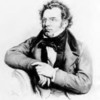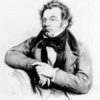quote:
Originally posted by Vicky2:
Thank you Teo.
I think I will join the dance.



Love
Vicky

Nice job Teo! You got them dancing!

Margherita, do you know how they dance to "Deutscher Tanze in C Sharp Minor(D643)?"
I need tips! I have 2 left feet! Here is more for
The Merry Schubertiaden! 
quote:
Schubert, An Intriduction To His Piano Works
page 2
Schubert was born in Vienna in 1797. His father was a schoolmaster and an amatuer cellist. When he was 7, Schubert's father taught him to play the violin and his older brother Ignaz taught him the piano. He studied singing, counterpoint and organ playing with Michael Holzer, the parish organist, who said in later years that Schubert always seemed to know everything by instinct before he could teach it to him. At 11, Schubert was awarded a scholarship as a boarding student at the famous Vienna Imperial and Royal Seminary, which also trained choristers for the Royal chapel. He was a good student, and was always praised particularly for his musical abilities. He played violin, and conducted the school orchestra when the regular master was absent. He began composing under his teacher's direction, Antonio Salieri.
Schubert had the opportunity to hear performances of the great works of music. He was much impressed by Mozart's Magic Flute, Gluck's Iphigenia in Tauris and Beethoven's Fidelio. The music of Handel, both Joseph and Michael Haydn, Rossini and Cherubini also influenced him greatly.
After his voice changed, Schubert taught in his father's school, even though his true inclination was only to be a musician. He was not conscripted for military service because he was too short, about 5'1". During the teaching years, he continued to compose, writing songs, piano music and masses for the church. His comments in his diary reflect that he had also become somewhat of a philosopher. He wrote: "The heart is the ruler but the mind ought to be," and "Take people as they are, not as they should be."
When his friend, the poet Schober, offered him a place to live, Schubert was glad to give up teaching and to devote himself to composing. Aside from the summers of 1818 and 1824, spent at Count Esterhazy's estate in Hungary teaching music to the family, Schubert spent the remainder of his life in and near Vienna. He was too impoverished to marry the great love of his life, Theresa Grob, but never forgot her. Though he became fond of many others, he remained a bachelor.
On of the most influential of his many friends, the well-known operatic baritone Johann Michael Vogl, was instrumental in making Schubert's songs famous. It was he who sand the best known of all his sings, Erl King, making it instantly popular. The two became devoted to each other and Schubert said that their style of playing and singing together as co-interpreters rather than as soloist and accompanist was quite novel to the people who heard them. Vogl himself regarded Shubert's inspirations as "veritably divine." Vogl's performances contributed greatly to the interest the Viennese publishers began to take in Schubert's compositions. It is, sadly, a fact that his publishers often treated him badly, paying the smallest amounts possible for his works, publishing them in unauthorized arrangements, making alterations without consulting him and sometimes totally neglecting the important works. Schubert, probably because of his poverty and natural shyness, usually made little protest.
The warmth of affection his personality always generated towards his friends led to the Schubertiaden. These were evening musicales held by his wealthy friends in their lovely homes, and their purpose was to hear Schubert's music. Frequently, the finest singers of the day came to delight the audience with his newest songs, often with Schubert himself playing the accompaniments. The piano duets were popular and late in the evening Schubert would improvise piano music for dancing.
page 6
Ornamentation in Schubert's music
During Schubert's lifetime, the earlier 18th century practice of adding improvised ornamentation in performance was gradually dying out. In a concert review of 1820, however, the writer complains that a singer "should not have troubled himself to ornament" one of Schubert's songs at the close "since he did it so badly." In general, only singers continued to add ornaments as late as Schubert's time. The performer need not feel obligated to add any to the pieces in the present volume, but those which Schubert wrote should not be omitted.
The style of performing certain ornaments was gradually changing throughout the 18th and 19th centuries, reflecting the changing style in composition. For a long time, however, both the old and new styles occurred side by side, and there are places where it is impossible to know definitely which style is intended.
Schubert himself wrote nothing about ornamentation, so far as is known. The writings of his contemporaries, Turk (1789), Adam Pe're (1798), Kalkbrenner (ca. 1800), Clementi (1801), Cramer (1810) and Hummel (1828) have been consulted and compared with the earlier writers, QUantz (1752), Marpurg (1756), C.P.E. Bach (1759) and Leopold Mozart (1787), The discussion which follows reflects both the older style where it still continued to be used, and the newer style which Schubert sometimes used. Schubert's contemporaries agree in all but very minor details. In particular, they agree that all ornaments are played on the beat, taking their time value from the main note which follows them. It was not until much later in the 19th century that ornaments customarily began to anticipate the beat, and editions printed during that time reflect the later custom. The realizations in light print in the present edition follow the custom which still prevailed during Schubert's lifetime, of performing all ornaments on the beat, unless they were specially written otherwise.
Love,
Arty




